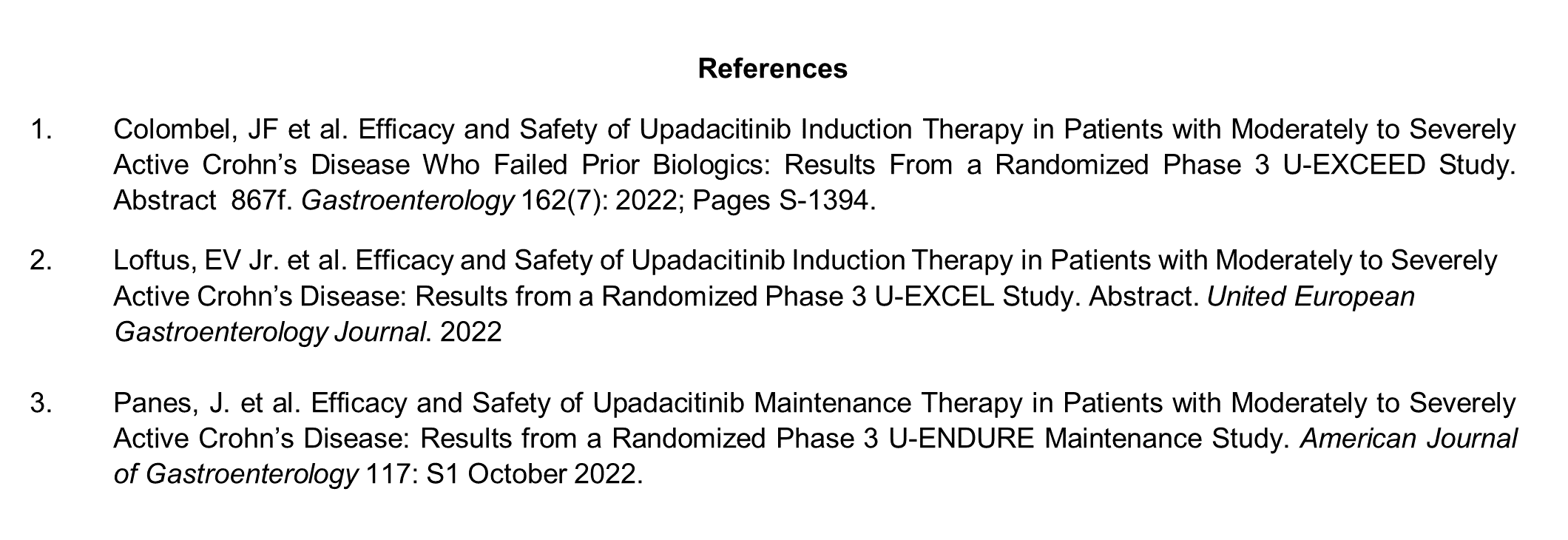OP17 Upadacitinib Improves Endoscopic Outcomes in Patients with Moderate to Severely Active Crohn’s Disease Irrespective of Previous Failure to Respond to Biologics or Conventional Therapies
Feagan, B.G.(1)*;Horst, S.(2);Dryden, G.(3);Lindsay, J.O.(4);Ferrante, M.(5);Dubenco, E.(6);Lacerda, A.P.(6);Ford, S.(6);Anyanwu, S.I.(6);Zhou, Q.(6);Liu, J.(6);Chen, M.(7);Schreiber, S.(8);
(1)Western University, Division of Gastroenterology- Department of Medicine, London, Canada;(2)Vanderbilt University Medical Center, Department of Gastroenterology- Hepatology- and Nutrition, Nashville, United States;(3)University of Louisville, Department of Microbiology & Immunology- Brown Cancer Center, Louisville, United States;(4)Queen Mary University of London, Centre for Immunobiology- Barts and the London School of Medicine and Dentistry-, London, United Kingdom;(5)University Hospitals Leuven, Department of Gastroenterology, Leuven, Belgium;(6)AbbVie, none, North Chicago, United States;(7)The First Affiliated Hospital of Sun Yat-sen University, Division of Gastroenterology, Guangzhou, China;(8)Christian-Alrechts-University, Department Internal Medicine, Kiel, Germany;
Background
Upadacitinib (UPA), an oral, reversible JAK inhibitor, demonstrated superior efficacy compared to placebo (PBO) in patients with moderate to severe Crohn’s disease (CD) in 2 multicentre, phase 3 induction (U-EXCEL and U-EXCEED), and 1 maintenance (U-ENDURE) trial.1-3 This sub-analysis assessed endoscopic outcomes in patients with or without a history of biologic failure (inadequate response or intolerance) among those receiving UPA treatment.
Methods
Eligible patients had average daily stool frequency [SF] ≥4 and/or abdominal pain score [APS]≥2, plus a Simple Endoscopic Score for CD (excluding the presence of narrowing component) ≥6 [≥4 for isolated ileal disease]). Patients received UPA 45 mg once daily (QD; UPA45) or PBO (2:1) for 12 weeks (wks). Patients that achieved SF/APS clinical response after 12 weeks of treatment with UPA45 (≥ 30% decrease in daily very soft/liquid SF and/or ≥ 30% decrease in daily abdominal pain APS with neither worse than baseline) were re-randomized (1:1:1) to UPA 30 mg QD (UPA30), UPA15 mg QD (UPA15) or PBO for 52 wks of maintenance. Endoscopic response\ remission were evaluated by central reading at wk 12 induction and wk 52 maintenance. Adverse events (AEs) were assessed through wk 52. Statistical significance in comparisons was not assessed due to an inability to control for type I error in subgroup analysis.
Results
Baseline characteristics/demographics were similar across treatment groups. In the pooled induction population (U-EXCEED+U-EXCEL), 72.0% UPA45 and 71.5% PBO patients had history of prior biologic failure. In U-ENDURE, 73.4% UPA15, 75.6% UPA30, and 76.4% PBO patients had history of prior biologic failure. In patients without or with biologic failure, UPA demonstrated higher rates for endoscopic response compared to PBO at wk 12 (52.0%, 35.7% UPA45 vs 16.2%, 5.3% PBO, Figure 1A) and wk 52 (Figure 1B). Similarly, in patients without or with a history of biologic failure, UPA exhibited higher rates of endoscopic remission at wk 12 (36.0%, 19.6% UPA45 vs. 10.1%, 2.8% PBO, Figure 1A) and wk 52 (Figure 1B). Differences from PBO were found in endoscopic response or remission in patients that remained in response/remission from the entry of maintenance to wk 52 for either dose, regardless of prior history of biologic failure (Figure 1C). UPA treatment was well-tolerated, with no new safety risks observed compared to the known safety profile of UPA (Tables 1-2).



Conclusion
Upadacitinib achieved clinically meaningful endoscopic outcomes, which were maintained up to 1 year, irrespective of a patient’s prior biologic treatment, with an acceptable safety profile. 


